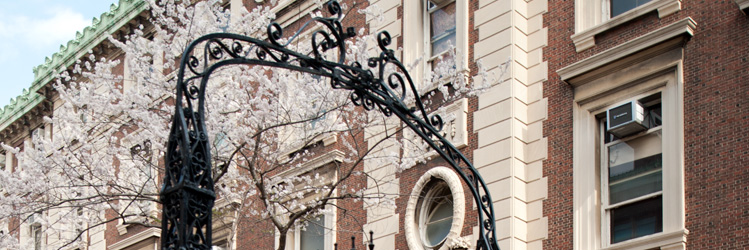
Columbia University
The Career Diversity Pilot Phase began in 2013 and concluded in 2016. This page was last updated on September 14, 2015. To find up-to-date information about the Career Diversity initiative, click here.
At Columbia University's Department of History, the effort is to think broadly about where history is located and how it is enacted. We want to focus on the skills-training needed for all graduate students within an intellectual paradigm. We see this initiative as relevant to all of our graduate students, regardless of their temporal or geographic specializations, and in full sync with their own understandings of how they think of their scholarship. Under our "History in Action" programming, we will introduce our students to diverse professionals, trainings, and ideas that will not only make them a better historian, but prepare them to be productive members of a wide array of communities in the world. HIA is led by Project Director Professor Adam J. Kosto. For AY 2015-16, Professor Karl Jacoby and Associate Professor Rebecca Kobrin are the Faculty Coordinators, and Jake Purcell and Caroline Marris are the Graduate Student Coordinators.
The History in Action Initiative at Columbia University's Department of History has four components stretching across the academic year:
- History in Action Project Awards (HAPA): Each semester, graduate students are invited to apply for small-project grants which will support diverse activities—working in community archives, museums, publishing, grant-writing, pedagogy etc. We welcome all serious engagements with the mission of the HIA and these grants should be seen as seed-money for creative and scholarly projects. You can see the Awards for Spring 2015 here and read about the Summer 2015 Awards here.
- History in Action Research Assistantships (HARA): Each semester, graduate students are invited to apply to work with host organizations as Research Assistants. The HARA is run in co-operation with the Center for Career Education at Columbia. The RAs receive TA relief for the semester and their work is commensurate to the weekly TA duties. We have developed, in conjunction with CCE, a "Skills Profile" for our graduate students, to convey to the host organizations the types of transferrable skills they bring. In the first phase, the host organizations have been chosen by HIA and CCE but we will initiate a proposal format wherein graduate students can bring a host organization they specifically want to work with into the program. The aim here is two fold: First, to create institutional relationships with organizations and the Department of History. Second, to ensure that the RAship introduces the graduate students to new, critical skills, methods, and exposes them to a diverse learning opportunities. In Spring 2015, HARA recipients worked on exhibitions at the Brooklyn Historical Society and reviewed classical music for the New York Times. You can read about the Spring 2015 HARA fellows here. In AY 2015-16, HARA recipients will undertake work with the Social Science Research Council, the Tenement Museum of New York, and the Institute for New Economic Thinking. You can read more about AY 2015-16 HARA fellows here.
- History in Action Clinic Courses: In the Spring Semester 2015, HIA offered a clinic course as a cluster of workshops. Graduate students were welcome to either take the course for credit, or attend any of the individual workshops. Each workshop was run by a noted professional and focused on process and skills. You can find the Spring 2015 workshops here. In AY 2015-16, the clinic course "The Politics of Historical Dialogue: Civil Society Advocacy" will run in conjunction with the Institute for the Study of Human Rights. The course will be led by Professor Elazar Barkan. Details are available here.
- History in Action Conference: On January 21-22, History in Action will host a conference organized by graduate students and extending the themes and questions raised during the previous HIA conferences. HIA III will be a continuation of HIA II and of the first HIA conference, which seeded the idea of this entire project.
Finally, Miguel Ripoll Design has created a truly interactive website for HIA. The website allows faculty and graduate students to publish in different mediums and formats, as well as host dialogues and create interactions with the wider world. We are very excited by the social media and on-line publishing possibilities that the new website offers.
Updated on September 14, 2015
